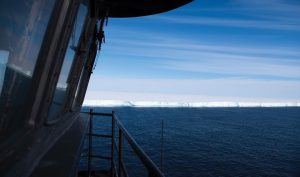
Crew members of the U.S. Coast Guard cutter Polar Star were working with Guinness World Records to become the new official record holders of being able to reach the planet’s southernmost navigable waters.
While traveling the Bay of Whales ice harbor near Antarctica in February, the Seattle-based cutter surpassed USCG cutter Polar Sea’s 1997 Guinness World Record, reaching “a position of 78 degrees, 44 minutes, 1.32 seconds south latitude at 12:55 p.m. (Feb. 17) New Zealand time, holding a distance of approximately 500 yards from the edge of the Ross Ice Shelf,” according to the agency.
Polar Star traveled in waters that used to be charted as part of the ice shelf; now parts of the Ross Ice Shelf deviate about 12 nautical miles from the positions shown on official charts, USCG said, adding that the cutter surveyed 396 nautical miles of the ice shelf for possible navigational use for the future.
On Feb. 7, 1997, Polar Star’s sister ship, the U.S. Coast Guard cutter Polar Sea (WAGB 11), reached 78 degrees, 29 minutes south latitude.
In 1908, explorer Ernest Shackleton gave the Bay of Whales its name during the Nimrod Expedition on the basis of the numerous whales he and his crew sighted. Three years later another explorer, Roald Amundsen, established a base camp in the bay, from which he set out on his successful endeavor to become the first person to reach the South Pole. Years later, U.S. Navy Rear Adm. Richard E. Byrd established Little America in the Bay of Whales during his first, second, and third Antarctic Expeditions, exploring more than 60% of the Antarctic continent.
“The crew of Polar Star is proud to follow in the footsteps of legendary Antarctic explorers like Shackleton, Amundsen, and Byrd,” said Capt. William Woityra, commanding officer of Polar Star. “Even today, more than a century later, we carry on that legacy of exploration, reaching new places, and expanding human understanding of our planet.”
Cutter Polar Sea previously held the world record in 1997 when it reached 78 degrees, 29 minutes south latitude, according to the USCG.
It can take up to 12 weeks for a world record to be certified, according to Guinness World Records.

In other Polar Star news, on Feb. 7, the cutter arrived at McMurdo Station in Antarctica for its annual participation in Operation Deep Freeze, an annual mission resupply that aids the U.S. Antarctic Program’s lead agency, the National Science Foundation (NSF).
McMurdo Station is the largest Antarctic station, as well as the U.S. Antarctic Program’s logistics base.
This was the 25th time the Seattle-based vessel, the Coast Guard’s only heavy icebreaker, supported the mission. The operation involves cutting through ice as thick as 21 feet to clear a pathway for vessels to bring fuel and supplies to the station, considered the U.S. Antarctic Program’s logistics hub.
Each year, the crew pilots the 399-foot, 13,000-ton cutter to break a navigable channel through miles of ice, sometimes as much as 21-feet thick.
Early in January, Polar Star crew members arrived at Ross Sea, Antarctica and began cutting through 37 miles of ice from the ice pier in Winter Quarters Bay at McMurdo to open waters. The vessel prepared the channel for two ships, Maersk Peary and Ocean Giant, to unload more than eight million gallons of fuel and 1,000 cargo containers, enough to sustain the Antarctic Program’s operations until summer 2023.
“We are excited to welcome the return of the Polar Star to McMurdo Station this year,” Stephanie Short, head of NSF’s Antarctic Infrastructure and Logistics section said. “Continuing the U.S. Antarctic Program’s vital operations would simply not be possible without [the cutter’s] support and the hard work of the captain and crew.”
As America’s only heavy icebreaker, Polar Star is able to carve out a path through ice as thick as 21 feet.
To keep its presence in the polar regions, the Coast Guard has said that it’s looking to invest in its polar icebreaker fleet and is looking at ways to expand its infrastructure at Base Seattle to accommodate a growing fleet of icebreakers.
Expanding the fleet would “ensure access to the Polar Regions, project U.S. sovereignty, and to protect the country’s economic, environmental and national security interests,” according to the USCG.

